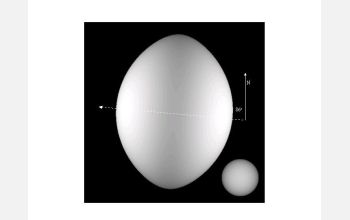News Release 05-007
Portrait of a Star on the Edge
A new telescope array yields an unprecedented close-up of the bright star Regulus
January 19, 2005
This material is available primarily for archival purposes. Telephone numbers or other contact information may be out of date; please see current contact information at media contacts.
Arlington, Va.—Astronomers have known for decades that Regulus, the brightest star in the constellation Leo, is living very close to the edge.
Only a few hundred million years old—young by stellar standards—Regulus has some three-and-a-half times the mass of our own middle-aged Sun, some 350 times its energy output, and a truly prodigious rate of spin. Our Sun makes one sedate rotation every 24 Earth days; Regulus whips around in less than one day. Indeed, its equator is moving at well over 700,000 miles per hour—perilously close to the speed at which the outward-pointing centrifugal force would cancel out the inward pull of the star's gravity. If Regulus were spinning even 10 percent faster, it would tear itself apart.
Scientists at Georgia State University's Center for High Angular Resolution Astronomy (CHARA) have now detailed some of the consequences of such behavior. Using their recently completed array of optical telescopes atop California's Mount Wilson, the CHARA astronomers have measured Regulus' size and shape, the temperature difference between its poles and equator, and the orientation of its spin axis.
Their results are summarized in this computer-generated model of the star, which is shown with a similar model of our Sun for scale. The model is tilted on its axis 86 degrees from celestial north—just as the real Regulus appears in the sky. That makes the axis almost horizontal in this picture, and the equator almost vertical.
Regulus' frenetic spin gives the star its grossly bulging mid-section; its equatorial diameter is one-third larger than its north-south diameter. But almost as striking is the "gravity darkening" in the midsection: Regulus' rotation lowers the pull of gravity at the equator, which in turn lowers the temperature there and dims the light output. Indeed, CHARA researchers have found that Regulus is five times brighter at the poles, where the temperature is 27,200 degrees Fahrenheit, than it is at the equator, where the temperature is 18,000 degrees Fahrenheit. For comparison, the surface temperature of our Sun is "only" 10,000 degrees Fahrenheit.
One additional oddity: Regulus' axis of rotation happens to point in the same direction as its motion through the galaxy—which means it zips along (from right to left in this picture) like an enormous, spinning bullet.
The researchers' observations of Regulus represent the first scientific output from the CHARA array, and will be published this spring in The Astrophysical Journal. The array itself was constructed with funding from the National Science Foundation (NSF), Georgia State, the W. M. Keck Foundation, and the David and Lucile Packard Foundation. In coming years the scientists will be pointing the array at many other single- and multiple star systems, using its ultra-high-resolution imagery to test the prevailing theories of how stars form, how they are structured, and how they evolve.
-NSF-
Media Contacts
M. Mitchell Waldrop, NSF, (703) 292-8070, email: mwaldrop@nsf.gov
Program Contacts
Michael Briley, NSF, (703) 292-4901, email: mbriley@nsf.gov
Principal Investigators
Harold A. McAlister, Georgia State University, (404) 651-1390, email: hal@chara.gsu.edu
Related Websites
The CHARA web site: http://www.chara.gsu.edu/CHARA/
Georgia State University press release: http://www.eurekalert.org/pub_releases/2005-01/gsu-as011805.php
The U.S. National Science Foundation propels the nation forward by advancing fundamental research in all fields of science and engineering. NSF supports research and people by providing facilities, instruments and funding to support their ingenuity and sustain the U.S. as a global leader in research and innovation. With a fiscal year 2023 budget of $9.5 billion, NSF funds reach all 50 states through grants to nearly 2,000 colleges, universities and institutions. Each year, NSF receives more than 40,000 competitive proposals and makes about 11,000 new awards. Those awards include support for cooperative research with industry, Arctic and Antarctic research and operations, and U.S. participation in international scientific efforts.
Connect with us online
NSF website: nsf.gov
NSF News: nsf.gov/news
For News Media: nsf.gov/news/newsroom
Statistics: nsf.gov/statistics/
Awards database: nsf.gov/awardsearch/
Follow us on social
Twitter: twitter.com/NSF
Facebook: facebook.com/US.NSF
Instagram: instagram.com/nsfgov



